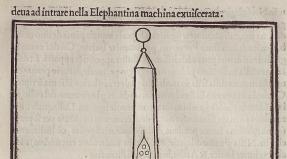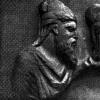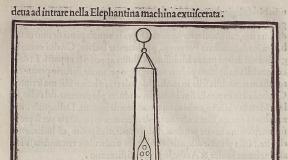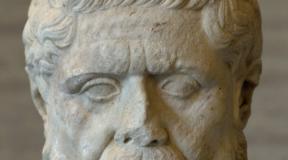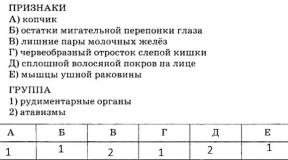Obelisk on Cathedral Square
Piazza della Minerva is located. It is named after the important basilica - Santa Maria sopra Minerva, one of the main churches of the Roman Catholic Dominican Order.
The church, in turn, owes its name to a mistake: it was believed that it was built on the ruins of the ancient temple of Minerva. Indeed, there was a temple of Minerva somewhere on the Campus Martius, but the place of the church was most likely occupied by the temple complex of Isis and Separis.
Isis was an Egyptian goddess, but the Romans easily accepted foreign gods into their Pantheon. The cult of Isis and the general fascination with Egypt under Augustus became very fashionable in Rome. Over the centuries, time destroyed and buried these pagan temples, and in the area adjacent to the current Church of Santa -Maria sopra-Minerva, we found several Egyptian obelisks that may have stood in pairs in front of the entrance to the Temple of Isis. One now decorates the fountain in front of the Pantheon, the other stands on the back of an elephant in Minerva Square.
The obelisk on the back of an elephant, which in Rome is affectionately called the “chicken of Minerva” (pulcino della Minerva), dates back to the reign of Pharaoh Apria (VI century BC; in the Bible he is mentioned under the name Horf). Historians suggest that the obelisk was brought to Rome from Heliopolis during the time of Emperor Domitian.
Pope Alexander VII Chigi decided to install an obelisk in the square in front of the church of Santa Maria sopra Minerva, since during his reign the obelisk was found in 1665. The pope was delighted by the discovery with hieroglyphs symbolizing sunlight and, in his opinion, the light of divine knowledge.
On the pedestal, in particular, it is written - “Just as the signs of wise Egypt (i.e. hieroglyphs) support the elephant, the strongest of all animals, so wisdom should support a strong mind.”
A competition was announced regarding the installation of the obelisk in the square in front of the church of Santa Maria sopra Minerva. Several famous architects took part in the competition, including Gian Lorenzo Bernini and the priest of the Dominican monastery, Padre Domenico Paglia. According to the project presented by the latter, the obelisk should was rested on small hills (the heraldic symbol of the Chigi surname) and surrounded by four dogs - a Dominican symbol, whose slogan “dogs of the Lord” emphasized loyalty to the Almighty. But this project was rejected by the pope, but he liked the presented works of Bernini. The pope’s choice fell to Bernini's project, where a standing elephant carried the entire weight of the obelisk on its back.

In all likelihood, Gian Lorenzo was inspired to create such an image by the Renaissance mystical novel “Hypnerotomachia Poliphilus”, in which the main character dreamed of a stone elephant with an obelisk on his back, the book was accompanied by a corresponding illustration. The book had a great influence on the culture of the Renaissance, including literature, architecture and landscape art. The philosophically educated Pope Alexander VII was also a big fan of “Hypnerotomachy”.
However, the envious Padre Paglia, whose idea was rejected, convinced the commission and the pope that this monument would not be stable due to the hollow space at its base. They say, in this embodiment, the monument would become unstable and unsafe, which, in turn, would entail the collapse of the obelisk. Bernini was asked to develop a more stable base for the obelisk.
Bernini fiercely opposed any innovations, arguing that this would only worsen the appearance of the monument and cited the example of the obelisk in Piazza Navona, installed according to his design in the Fountain of the Four Rivers." There, a more powerful and heavier obelisk rose on a rock, hollow below. But Pope Alexander VII decided that additional support was still necessary for the safety of the monument.
As a result, a support appeared under the elephant's belly, which Bernini tried to hide with an elegant blanket. But in this final design of the monument, realized in 1667 by his student Ercole Ferrara, Bernini did not miss the opportunity to show his contempt for the Dominicans. The rear, indecent view of the sculpture, revealed by turning elephant's tail, was installed directly in front of the windows of the Dominican monastery.
Well, the monument itself, as expected, was decorated with all the signs of Pope Alexander VII’s involvement in the installation of this obelisk - the papal coat of arms on the pedestal and the heraldic eight-pointed star on top of the obelisk.

Bernini had never seen an elephant in his life, and when working he relied only on the words of eyewitnesses, which resulted in a rounded elephant that looked more like a well-fed pig. _-_The_Elephant_Hanno_-_Google_Art_Project.jpg) In those days, the elephant in Europe was almost a fabulous rarity. Those few animals that, with great difficulty, could be brought to the royal and papal courts, quickly died from the unusual climate and inept care. True, in the 9th century AD. At the court of Charlemagne, an elephant named Abul-Abbas, a gift from the legendary Caliph Harun al-Rashid, lived for several years, and six centuries later, at the court of Pope Leo X, the white elephant Hanno, a gift from the Portuguese king Manuel I, lived. A copy of Raphael’s drawing depicting Hanno has survived. The picture shows that Hanno was an Indian elephant.
In those days, the elephant in Europe was almost a fabulous rarity. Those few animals that, with great difficulty, could be brought to the royal and papal courts, quickly died from the unusual climate and inept care. True, in the 9th century AD. At the court of Charlemagne, an elephant named Abul-Abbas, a gift from the legendary Caliph Harun al-Rashid, lived for several years, and six centuries later, at the court of Pope Leo X, the white elephant Hanno, a gift from the Portuguese king Manuel I, lived. A copy of Raphael’s drawing depicting Hanno has survived. The picture shows that Hanno was an Indian elephant.
The new monument was nicknamed by the Romans “porcino/porcellino della Minerva”, or Minerva’s pig. This name eventually evolved into the modern name of the obelisk - “Pulcino della Minerva” - Minerva’s chicken, probably due to the similarity of the two words in the Roman dialect.
There is a legend that if you rub the tail of the elephant on which the obelisk stands, you can achieve some success in business and rise up the career ladder. And if you take a photo in front of the obelisk in Piazza Minerva, then life will be filled with happy moments.
The cradle of culture, science and military affairs. However, even in such an extraordinary city there was a place for imported wonders. The obelisks of Rome are a tribute to an even more ancient civilization, the Egyptian. Powerful pointed stone blocks soared into the sky of the Italian capital, decorating the squares of the Eternal City.
The term “obelisk” (Ancient Greek: βελίσκος) originated in Ancient Egypt and meant “small skewer.”
Looking at the stone monument, with a square cross-section and a pointed crown, you will inevitably agree that the stone mass resembles a giant spit. The Egyptians carved obelisks from a whole block of granite and covered them with inscriptions praising the sun god Ra (ancient Greek Ρα) and other celestial beings.
The height of the obelisks reached 30-35 meters, weight - 150-240 tons. The Egyptians erected similar monuments in pairs, as gates to the sanctuary of the god Ra. In Ancient Egypt, obelisks had great religious significance and were considered sacred. The Romans found utilitarian uses for ancient artifacts, using tall, pointed stone pillars as gnomons for sundials, markers on major roads, and memorials for nobles.
Interesting fact: the number of obelisks in Rome is “the devil’s dozen,” that is, 13.
The first person to turn his attention to ancient Egyptian monuments was (lat. Caesar Dīvī Fīlius Augustus). In 10 BC. he transported the first of the Egyptian obelisks from Heliopolis (ancient Greek: Ἡλίουπόλις) to Rome. In the Middle Ages, Italian architects reintroduced ancient obelisks into fashion. Thus, the luxurious architecture of the Middle Ages was complemented by Egyptian and Roman monuments.
Ancient obelisks
Dear reader, to find an answer to any question about holidays in Italy, use. I answer all questions in the comments under the relevant articles at least once a day. Your guide in Italy Artur Yakutsevich.
In order to look at the ancient obelisks of Rome, it is enough to take a special route starting in the center of the capital.
In Piazza del Popolo

This obelisk was the first monument to arrive from Egypt to Rome. Brought by Emperor Augustus from Heliopolis, the multi-ton stone pillar was subsequently installed in the open spaces (lat. Circus Maximus), as an indicator of the time on a sundial. During the collapse of the Roman Empire, the obelisk was buried underground. At the end of the 16th century, Pope Sixtus V (Latin: Sixtus V) ordered the newly discovered obelisk to be installed in the center (Piazza del Popolo). In 1823, the monument was additionally decorated with statues of lions emitting fountains of water from their mouths, made in the Egyptian style.
The current height of the obelisk is 24 m, with its original parameters - 36 m.
- Address: Piazza del Popolo
- Metro:
- By bus №301,628
On Pincio Hill, Villa Borghese

The ancient obelisk, about 17 meters high, was unknown to the general public until the 16th century, when it was discovered by archaeologists near Porta Maggiore. The sacred pillar changed several places (Palazzo Barberini,) and ended up on the Pincio hill.
- Address: Via Gabriele d'Annunzio
- Metro: Line A (Flaminio metro station)
- By bus №61,89,160,490,495,590
In Piazza Trinita dei Monti

Above, in the center of Trinita dei Monti square, there is an obelisk, which is a smaller copy of what Emperor Augustus brought. This monument was once intended to decorate the Gardens of Sallust (Horti Sallustiani) in Ancient Rome. The obelisk owes its discovery to the noble Italian family Ludovisi, who presented their find as a gift to Rome. The obelisk spent some time in the square (Arcibasilica Papale di San Giovanni in Laterano), but it was installed at the end of the 18th century in the square near the Church of Trinita dei Monti.
- Address: Piazza della Trinita dei Monti
- Metro: line A (metro station "Spagna")
In Piazza Navona

The 30-meter obelisk was brought to Rome by Emperor Domitian (Latin: Titus Flavius Caesar Domitianus) in the 1st century AD. It was a duplicate of the sacred pillar installed in the temple of the god Serapis (Greek: Σέραπις). In the 3rd century AD. the monument was placed in the Circus Maximus, according to the will of Emperor Maxentius (Latin: Marcus Aurelius Valerius Maxentius).
In the first half of the 17th century, an English count bought an obelisk divided into 4 parts and wanted to take it to Britain, which was prevented by Pope Urban VIII. In 1651 (Gian Lorenzo Bernini) made the ancient obelisk part of a sculptural group (Fontana dei Quattro Fiumi) installed in the center (Piazza Navona).
- Address: Piazza Navona
- By bus №30,40,46,62,63,64,70,81,87,116,492,571,628,630,780,916
In Piazza del Rotonda
The monument, rising on the Piazza della Rotonda, in front of the entrance to the (Latin Pantheon), is one of the paired obelisks that once marked the entrance to the Temple of Ra at Heliopolis. The height of the monument is 6.34 m without a pedestal, which makes it much shorter than its counterpart installed at Villa Celimontana. In ancient times, an obelisk was installed at the entrance to the sanctuary of Isis, and was lost over time. In the 14th century, a stone pillar was found during the construction of the Church of San Macuto (Chiesa di San Macuto).
Only in 1711 the obelisk took its current place in front of the Pantheon by order of Pope Clement XI (lat. Clemens XI). The obelisk is decorated with a fountain designed by Filippo Barigioni.
- Address: Piazza della Rotonda
- By bus №30,51,62,63,70,81,83,85,87,160,492,628
In the Piazza del Minerva

One block from the Pantheon is Piazza della Minerva and the church of the same name (Santa Maria sopra Minerva). Near the entrance to the church there is one of the paired obelisks, originally from the Egyptian Sais (ancient Greek Σάϊς). A small obelisk, less than 6 m high, looks solemn and sophisticated. Brought in the 1st century AD. Domitian to decorate the Temple of Isis; this monument was reused by Bernini in the 17th century to decorate a Roman piazza.
The pedestal in the shape of a baby elephant makes the obelisk especially touching. Thus, the most talented sculptor symbolized the highest wisdom of God.
- Address: Piazza della Minerva
- By bus No. 70,81,87,492,628,N6,N7
In Piazza Montecitorio

It is believed that this obelisk was also brought to the capital by Emperor Augustus from Heliopolis in the 1st century AD. The height of the obelisk is 22 m, which made it possible to use it as a gnomon for a sundial on (lat. Campus Martius).
The obelisk was discovered again in the 16th century, but there was no rush to remove it from the earth. Archaeologists retrieved and restored only the pedestal of the monument, initially attributing it to Emperor Mark Antony. Already at the end of the 18th century, Pope Pius VI (lat. Pius VI) decided to use a red marble obelisk to decorate Piazza di Montecitorio.
- Address: Piazza di Monte Citorio
- By bus No. 51,62,63,83,85,160,492,N4,N5,N12,N25
In St. Peter's Square

The stone spire is 25.5 meters high, originally intended for the Forum Iulium in Egyptian Alexandria (Old Ἀλεξάνδρεια), by the Roman prefect Cornelius Gallus. This monument, created in the 1st century BC. and was notable for the fact that it did not contain hieroglyphs. In the 40s AD. Caligula (lat. Gaius Julius Caesar Augustus Germanicus) moved the pillar to Rome in order to decorate the Circus of Nerone (Circo di Nerone).
At the end of the 16th century, Pope Sixtus V ordered the obelisk to be transported to St. Peter's Square in the Vatican. To transport the multi-ton stone block, a technique developed by the architect Domenico Fontana was used.
It is noteworthy that this obelisk is the only one that was not overthrown or destroyed during the oblivion of the Roman Empire. Another interesting fact: the ball installed on top of the monument was for a long time considered to be a receptacle for ashes (lat. Gaius Julius Caesar). When Fontana dismantled the decoration and handed it over to the museum, it turned out that only centuries-old dust was stored in it.
This obelisk stands opposite (Basilica di San Pietro) - the patriarchal basilica.
- Address: Piazza San Pietro, Vaticano
- Metro: line A (Ottaviano – San Pietro station)
- By bus № 23,32,34,40,46,49,62,64,81,98,271,492,571,870,881,907,916,982,990
- Tram №19
In Piazza San Giovanni in Laterano
The tallest obelisk in Rome rises 38.12 meters above the ground. And its weight is 230 tons, which makes it the record holder for power among similar monuments around the world.

The first place of “registration” of this curiosity was the temple of the Egyptian god Amon-Ra (ancient Greek Ἅμμων Hámmōn) in Karnak. In the 4th century AD ruler Constantine II (lat. Flavius Julius Constantius Augustus) brought several obelisks, including the largest pillar, to Rome. In 357 AD. the giant monument became part of the decoration of the Circus Maximus.
Many centuries later, after the fall of the great Rome, the obelisk was rediscovered, split into three parts. In 1587 it was reassembled, losing 4 meters from its original height. The new place of "residence" of the grandiose artifact was the square near the Lateran Palace (Palazzo del Laterano) - the residence of the pontiffs of the Vatican and the papal basilica of San Giovanni in Laterano (Basilica di San Giovanni in Laterano), on the site of the gilded equestrian statue of Marcus Aurelius (lat. Marcus Aurelius Antoninus Augustus), moved to (Campidoglio) Rome.
- Address: Piazza di San Giovanni in Laterano
- Metro: line A (San Giovanni station)
- By bus № 81,85,117,650,665,673,714,792
- Tram №19
On the Esquiline Hill
Esquilino, one of the obelisks removed from the tomb of Alexander the Great in Alexandria. Later, the monument and its double were installed at the entrance to the mausoleum of Emperor Augustus on the Campus Martius.
The pillars were excavated from the ground at the beginning of the 16th century, and one of them was installed at the papal basilica (Basilica di Santa Maria Maggiore) in Piazza dell’ Esquilino, and the second at the Quirinal Palace (Palazzo del Quirinal). All work was carried out under the constant guidance of the beloved architect of Pope Sixtus V, Domenico Fontana.
- Address: Piazza dell'Esquilino
- By bus №16,70,71,75,117,360,649,714
- Tram No. 5 and 14
In Piazza Quirinale
The obelisk in Quirinale Square (Piazza del Quirinale) is an exact copy of the obelisk installed on Esquiin Hill. Smooth surface of stone obelisks, freedom from hieroglyphs. The height is almost 15 m. Discovered at the beginning of the 16th century, the pillar was not used until 1786. By order of Pope Pius VI, the obelisk was erected near the marble statues of the Dioscuri (Ancient Greek: Διόσκοροι) on the square near the Quirinal Palace - the official residence of the President of Italy.
- Address: Piazza del Quirinale
- By bus№64,70,117,170
In the Baths of Diocletian
In the original, the obelisk that now adorns the Baths of Diocletian (Terme di Diocleziano) had a twin brother, together with whom it was placed in Heliopolis in the temple of Pharaoh Ramses II. At the dawn of our era, the Romans transported the monument to Rome to the Temple of Isis. In 1883, Rodolfo Lanciani again discovered the pillar in the thickness of the earth, during excavations near the church of Santa Maria sopra Minerva.
For a long time, a stone “candle” stood opposite the entrance to (Stazione Termini). The stone pillar became part of a memorial dedicated to the Italian soldiers who died in 1887 at the Battle of Dogali in Ethiopia. In 1924, the star-topped memorial was moved from the station's Piazza dei Cinquecento to the gardens at the Baths of Diocletian.
- Address: Viale Luigi Einaudi
- Metro: line A (station “Repubblica – Taetro Opera”)
- By bus №40,60,64,70,82,85,170,590,910
At Villa Celimontana

The luxurious gardens on the Celio hill are decorated with an obelisk brought from Heliopolis in the 2nd century AD. It is known that the original height of the monument was about 12 m, while the current one is only 2.68 m. The Romans used it to decorate the sanctuary of Isis near the church of Santa Maria sopra Minerva.
The next time the obelisk was found and used was in the 14th century to decorate the Basilica of Santa Maria in Aracoeli on Capitoline Hill. In the second half of the 16th century (Michelangelo di Lodovico Buonarroti Simoni) was involved in the reorganization of the gardens at Villa Celimontana, then still called Villa Mattei. An ancient obelisk was used as one of the decorative elements of the garden. Lost again, the pillar was discovered in the 19th century, in a ruined state. It was then that its height was reduced by 4 times, which makes the obelisk the smallest in the collection of similar Roman monuments.
- Obelisk at the Villa Medici- a copy, made in the 19th century, of an ancient artifact found in the gardens of the estate and transported to Florence (Firenze).
- Two obelisks, made of Baven granite, installed at Villa Torlonia at the end of the 19th century.
- In 1932 obelisk made of Carrara marble was installed in the Italian Forum (Foro Italico) in honor of Duce Mussolini (Benito Amilcare Andrea Mussolini).
- In the quarter of the World Exhibition in Rome, the EUR (Esposizione Universale di Roma) in 1959, a 45-meter white marble obelisk dedicated to the inventor Guglielmo Marconi.
↘️🇮🇹 USEFUL ARTICLES AND SITES 🇮🇹↙️ SHARE WITH YOUR FRIENDS
In the center of the cathedral square of the Trinity-Sergius Lavra, in front of the southern façade of the bell tower, rises a structure characteristic of the era of classicism - a stone obelisk. It is a tetrahedral pillar mounted on a high pedestal, tapering upward, made of hewn sandstone and topped with a gilded copper ball. On the pedestal, on all four sides, there are four oval copper boards with texts engraved on them, listing the Lavra’s services to the Fatherland in “unlucky times for Russia” Tatar yoke, Time of Troubles and Streltsy rebellions, when Lavra “promoted and assisted in the preservation of the fatherland”.
The obelisk was installed by order of the Metropolitan of Moscow and Holy Archimandrite Lavra Platon (Levshina) V 1792, in the year of the 400th anniversary of the memory of St. Sergius of Radonezh. We learn about this from the text engraved on a copper board mounted on the western side of the pedestal:
In glorification of this monastery and in the eternal memory of the great men, St. Sergius, Archimandrites: Joasaph and Dionysius and Kelar Avramia, Plato, Metropolitan of Moscow and Archimandrite of this Lavra, erected and dedicated this monument 1792.
They are in Heaven: they don't need fame,
She should lead us to similar things.
It is known that the obelisk was erected by the artel of the peasant of the Olonets governorship, Gavrila Karetin, according to an agreement concluded with the Lavra in December 1791 and compiled in accordance with the instructions of Metropolitan Plato.
The stones of the obelisk were fastened together with iron filled with lead, and the seams between the stones were covered with cement with the addition of marble flour. When looking at the obelisk, it is easy to notice that one of the stones of its tetrahedral pillar is somewhat different from the others in structure and color. According to Karetin’s explanation given to Metropolitan Plato, a stone of a different “type” and color had to be replaced with a stone broken on the road when transporting it to the Lavra.
The resourcefulness of the contractor made it possible to fulfill the contract on time, and the obelisk decorated the central square of the Lavra for the day of honoring the memory of St. Sergius. In the printed description of the Lavra for 1796 we read:
“In 1792, in an open spatial place, between the bell tower and the Trinity Cathedral, on the one hand, and on the other, between the Assumption Cathedral and the Treasury line, a stone obelisk made of wild large and hewn stone, 14 arshins high, was erected on a platform with a step, and with a cabinet made of the same hewn stone. The top of the obelisk is finished with pointed marble, and a gilded copper ball made of fire is placed on it. On the same obelisk, on top of the pedestal, there is a sundial mounted on three sides, with gilded fire hands, and on the pedestal, on all four sides, there are four oval white marble boards, on which are briefly carved those monuments that have been used at different times in this the monastery became famous, and what services were rendered to the fatherland from it. This obelisk was built with the care and support of His Grace Metropolitan Plato.”
At first, the obelisk was surrounded by a fence made of wooden posts dug into the ground. IN 1823 A new fence was built from ancient cast-iron cannons removed from the Lavra towers and dug into the ground, connected by forged chains. Many images of the obelisk with cannons dug around it have been preserved.
IN 1930s Over the years, the white marble oval plaques with texts and the gilded copper ball that crowned the obelisk were lost, and the sundial was removed and placed on display at the state museum that opened on the territory of the Lavra. Loss 1930s years were replenished in 1950, when a new gilded ball was installed on the top of the obelisk, and exact copies of the old white marble boards, but now copper, were fixed on the pedestal.
A major overhaul of the obelisk was carried out in 2000 The main problem was the restoration of the foundation of this structure. The restoration of the foundation was carried out without dismantling the obelisk pedestal: pedestal "grabbed" and raised it on jacks, which made it possible to place a new foundation slab under the obelisk pedestal. Only the stones of the tetrahedral pillar were dismantled; then they were reassembled using new cement mortar. During the restoration process, the granite steps of the obelisk and the slabs of the pulpit in front of its eastern side were updated, a new sundial - exact copies of the old clock - was put into place, and the copper ball crowning the obelisk was gilded.
Place de la Concorde (Paris, France) - description, history, location, reviews, photos and videos.
- Tours for the New Year To France
- Last minute tours To France
Previous photo Next photo




Parisian Place de la Concorde is called one of the main squares of the city. It has the shape of a regular octagon, in each corner of which there is a statue symbolizing one of the French cities (Brest, Bordeaux, Lyon, Lille, Marseille, Nantes, Rouen and Strasbourg). Another famous monument is the huge Egyptian obelisk located in the very center.
An interesting fact is that in 1871–1918, when Strasbourg belonged to Germany, the face of the statue symbolizing it was covered with a mourning veil.
Short story
The design of the square was created in 1755 by Gabriel Ange-Jacques. After the Great French Revolution, a guillotine was installed in the center of the square, and it itself was renamed “Place of the Revolution”.
Many noble persons were executed in this square: Louis XVI, Marie Antoinette, Charlotte Corday, Madame Elisabeth and others. After the decline of revolutionary sentiment, the guillotine was removed. Somewhat later, the place was renamed “Place de la Concorde”.
In 1993, the French AIDS Society organized a provocative action: a giant pink condom was placed on the central obelisk.
Place de la Concorde
How to get there
You can get to the square by taxi or metro to Concorde station. In addition, more than 5 bus routes run through the square.
The obelisk was brought to Rome from Egypt during the reign of Emperor Caligula in 37. According to Pliny's description, its origin is from Heliopolis. Later, the obelisk stood at the Forum of Julia of Alexandria in Egypt, and in Rome it was installed in the center of the Circus of Nero. The obelisk remained in its established place even after the desolation of the Circus, until the formation of the necropolis there, and subsequently the construction of the ancient Basilica of St. Peter.
In 1586, by order of Pope Sixtus V and under the direction of the architect Domenico Fontana, the obelisk was transported and installed in the center of the square of St. Peter's Basilica.
Reference: The installation of the obelisk in the center of the square of St. Peter's Basilica was scheduled for September 10, 1586. First, the obelisk was placed and secured to the monolith, and then, using a special structure equipped with winches and rollers, it was placed on the ground. The operation was led by Domenico Fontana and required 900 workers, 140 horses and 44 winches. All approaches to the square were blocked, onlookers and curious crowds were forbidden to make any sounds under penalty of death. Orders were given using a bullhorn, drums and signal flags. They carefully and slowly lifted the obelisk onto the pedestal, but during the lifting the ropes supporting it weakened and this threatened to cause the obelisk to fall. Everyone froze in horror and deathly silence... and at that moment, in violation of the ban, a voice was heard from the crowd: “Water on the ropes!” It was the captain of the ship named Domenico Bresca from San Remo. He knew very well from his experience that when the ropes get wet, they tighten. So the obelisk was installed, and Captain Bresk was summoned to the Pope. He praised the captain and asked how he could thank him. In response, the captain asked permission to bring palm branches to the Vatican on Palm Sunday, which happens on the Sunday before Easter.
According to legend, the ball at the top of the obelisk contained the ashes of Caesar. Perhaps the winds of centuries blew it out of there, because when the obelisk was moved, nothing was found there except city dust. The ball, however, was placed in the Capitoline Museums, and a cross was placed in its place.
The obelisk is the second tallest after the Lateran. Its height is 25.50 meters, and together with the pedestal and cross on top it is 41 meters. It is the only obelisk that was not damaged.
Satellite map of the obelisk:
 |
|
 |
|
 |
|
 |
|
 |
|
 |
|
 |




